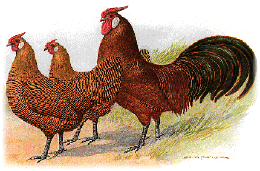
A painting of American style birds by
Edwin Megargee
The second season is used to mate sons back to dams.
The offspring from these matings will be used as intermediate breeders in further years.
They generally will not be the ones which will give you the best birds, but they will
genetically "set" certain traits. You may get lucky and breed the odd
"beauty" in these matings, but this is rare. Do not use any of the pullets from
the first mating, these will be grown on and bred with as hens.
Second Year
Select the very best of
the old hens used in the original matings. Be selective and choose only the very best. The
object is to use hens which show stronger traits of each strain. This means you will
select those hens which are closest to exhibition colour and markings for one mating and
those which are darker and mossy for the other. Separate them into two pens, according to
these characteristics.
For the exhibition cockerel strain, select a cockerel from the first seasons offspring,
closest to exhibition colour and markings. He will be mated to the old hens which show the
mossy pencilling and darker ground colour. If he has any particular faults, make sure any
hen with the same fault is not used with him.
For the exhibition pullet strain, select a cockerel which is too dark for exhibition, but
which carries pencilling on the wings and body. This male may also have pencilling on the
tail, so much the better if he has. He will be mated to the hens which are closest to
exhibition quality.
The Offspring
The progeny of the
second year will start to show marked improvement. You should be able to see specimens
which are clearly recognisable as either cockerel or pullet strains. You are now well on
the way to creating two outstanding exhibition lines.
This essay is written from my own
personal experiences and from hints given me by old breeders now passed on. |
The pullet breeding pen will have old hens with
|
Exhibition
quality ground colour
Sound markings on the breast
As even and perfect pencilling all over as can be found
and....
a cockerel from the first season with dark reddish bay
ground colour, fine, even pencilling on wings and rump and patches of pencilling on his
body. His tail will be black with coarse gold lacing and maybe some coarse pencilling as
well. |
The cockerel breeding pen will have old hens with
|
| Darker
reddish bay ground colour
Sound markings on the breast
Even pencilling all over with some mossiness permitted on back and wings
and....
a cockerel from the first season as sound and
close to exhibition colour and markings as possible |
|